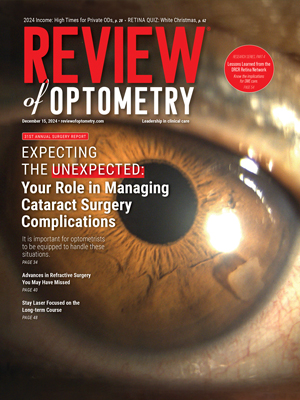Uveitis and increased intracranial pressure may lead to the development of uveitic optic disc edema (UDE) in some patients. Prompt diagnosis and treatment is important to preserve vision, but the clinical and imaging features of eyes of UDE aren’t currently well characterized. To help fill this gap, researchers at the University of Minnesota reviewed traditional structural and functional testing records of UDE patients seen over a three-year period by a single uveitis provider. They reported that a multimodal imaging approach is advantageous for diagnosing this potentially blinding condition.
|
When obtaining fluorescein angiography proves difficult, OCT disc raster height may suffice, the researchers say, noting the current fluorescein manufacturing shortages. This modality may also be used in with RNFL thickness as a substitute for treatment monitoring. Photo: Liaboe CA, et al. Cas Rep Ophthalmol Med 2020. Click image to enlarge. |
The case series included 55 eyes of 31 patients with UDE, aged 11 to 78. In these eyes, uveitis affected all anatomic compartments, including retinal vasculitis and choroiditis. The researchers reported that 24 (77.4%) patients had unilateral and seven patients (22.6%) had bilateral disc edema.
The researchers categorized visual field testing into seven groups based on severity: normal, scattered/nonspecific defects, blind spot enlargement, central/paracentral defects, nasal/arcuate defects, mixed defects and generalized depression. They reported that 12.7% of eyes had no defects or minor VF defects, 40% had focal VF defects and 47.3% had severe VF defects.
Average retinal nerve fiber layer thickness for the eyes in this study was 149 µm. The researchers reported a significant positive correlation between VF defect severity and RNFL thickness for the entire group. Structural optic disc raster OCT findings demonstrated no focal thickening in 7.3% of eyes, isolated nerve fiber layer thickening in 5.5%, focal inner-middle thickening in 32.7% and diffuse retinal thickening in 54.5%.
The researchers found that disc fluorescence on fluorescein angiography was significantly positively correlated with maximum disc height but not mean reflectance on OCT. They didn’t detect a relationship between these maximum disc height and mean reflectance.
Additionally, 29 of the patients underwent brain MRI. A total of five patients with bilateral disc edema had radiographic features, which the researchers wrote may indicate elevated intracranial pressure. Four of 31 patients had elevated opening pressure more than 25 cm H2O by lumbar puncture.
The researchers concluded that a multimodal imaging approach including RNFL OCT, OCT disc raster scan, visual field testing and fluorescein angiography can help make the UDE diagnosis. “OCT disc raster height may be used as a surrogate for FA intensity and may be a useful adjunctive modality for monitoring UDE severity along with serial OCT scans,” they wrote in their Journal of Neuro-Ophthalmology paper. “Increased intracranial pressure was rare in our patient cohort so neuroimaging should not be obtained solely based on optic disc appearance and imaging abnormalities.”
| Click here for journal source. |
Seela JR, Brandner DD, Ringeisen AL, et al. Clinical and imaging characteristics of uveitic optic disc edema. J of Neuro-Ophthalmology 2024;00:1-6. |


